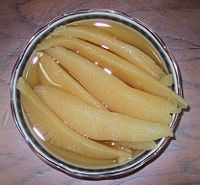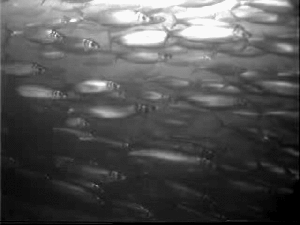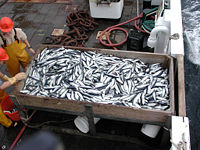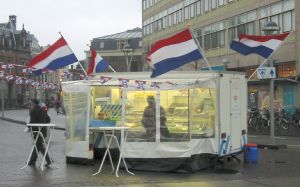Herring
| Clupeidae | ||||||||||
|---|---|---|---|---|---|---|---|---|---|---|
 Atlantic herring, Clupea harengus
| ||||||||||
| Scientific classification | ||||||||||
| ||||||||||
|
Dussumieriinae |
| Herring
| ||||||||||||
|---|---|---|---|---|---|---|---|---|---|---|---|---|
 Atlantic Herring
| ||||||||||||
| Scientific classification | ||||||||||||
| ||||||||||||
|
Clupea alba |
Herrings are small, oily fish of the genus Clupea found in the shallow, temperate waters of the North Atlantic, the Baltic Sea, the North Pacific, and the Mediterranean. There are 15 species of herring, the most abundant of which is the Atlantic herring (Clupea harengus).[citation needed] Herrings move in vast schools, coming in spring to the shores of Europe and America, where they are caught, salted and smoked in great quantities. Canned "sardines" (or pilchards) seen in supermarkets may actually be sprats or round herrings.
It includes many of the most important food fishes in the world.
Important commercial species include:
- Atlantic menhaden, Brevoortia tyrannus
- Atlantic herring, Clupea harengus
- Baltic herring, Clupea harengus membras
- Pacific herring, Clupea pallasii
- European pilchard, Sardina pilchardus
In The Netherlands, herring have played a major role in historical and economic development dating back to the 14th century.
Morphology
All of the 200 species in the family Clupeidae share similar distinguishing features. They are silvery colored fish that have a single dorsal fin. Unlike most other fish, they have soft dorsal fins that lack spines, though some species have pointed scales that form a serrated keel. They have no lateral line and have a protruding lower jaw. Their overall size varies from species to species: the Baltic herring is small, usually about 14 to 18 centimeters in length, the Atlantic herring can grow to about 46 cm (18 inches) in length and weigh up to 1.5 pounds (700 g), and Pacific herring grow to about 38 cm (15 inches).
Predators
Predators of adult herring include seabirds, dolphins, porpoises, seals, sea lions, whales, and humans. Sharks, dog fish, tuna, cod, salmon, halibut and other large fish also feed on adult herring. Many of these animals also prey on juvenile herring.
Diet
Young herring feed on phytoplankton and as they mature they start to consume larger organisms. Adult herring feed on zooplankton, tiny animals that are found in oceanic surface waters, and small fish and fish larvae. Copepods and other tiny crustaceans are the most common zooplankton eaten by herring. During daylight herring stay in the safety of deep water, feeding at the surface only at night when there is less chance of predation. They swim along with their mouths open, filtering the plankton from the water as it passes through their gills.
See Atlantic herring for videos of feeding juvenile herring, catching copepods.
Economy
Template:Commercial fish topics
Herring are an important economic fish. Adult fish are harvested for their meat and eggs. In Southeast Alaska herring is sold as baitfish. Environmental Defense suggests Atlantic herring (Clupea harengus) as one of the more environmentally responsible fish available.[1]
Cuisine
Herring has been a known staple food source since 3000 B.C.E. There are numerous ways the fish is served and many regional recipes: eaten raw, fermented, pickled, or cured by other techniques. The fish was sometimes known as "two-eyed steak".
Nutrition
Herring are very high in healthy long-chain Omega-3 fatty acids[2], EPA and DHA[citation needed]. They are a source of vitamin D.
Large Baltic herring slightly exceeds recommended limits with respect to PCB and dioxin. Nevertheless, the health benefits from the fatty acids are more important than the theoretical risk from dioxin; their cancer-reducing effect is statistically stronger than the cancer-causing effect of PCB's and dioxins.[3] The contaminant levels depend on the age of the fish which can be inferred from their size. Baltic herrings larger than 17 cm may be eaten twice a month, while herrings smaller than 17 cm can be eaten freely.[4]
Pickled herring
Pickled herring is a delicacy popular in Europe and has become a basic part of Jewish cuisine. Most cured herring uses a two-step curing process. Initially, herring is cured with salt to extract water. The second stage involves removing the salt and adding flavorings, typically a vinegar, salt, sugar solution to which ingredients like peppercorn, bay leaves and raw onions are added.
In Scandinavia, once the pickling process is finished and depending on which of the dozens of classic herring flavorings are selected, it is usually enjoyed with dark rye bread, crisp bread, or potatoes. This dish is a must at Christmas and Midsummer, where it is enjoyed with akvavit.
In Iceland, a blald is a young pickled herring given to a child as a special holiday treat.
In the Middle Ages the Dutch developed a special treat known in English as soused herring.
Pickled herrings are also common in Ashkenazi Jewish cuisine, perhaps best known for forshmak salad known in English simply as "chopped herring".
Pickled herring can also be found in the cuisine of Hokkaidō in Japan, where families traditionally preserved large quantities for winter.
Rollmops
The word Rollmops, borrowed from German, refers to a pickled herring fillet rolled (hence the name) into a cylindrical shape around a piece of pickled cucumber or an onion.
Fermented
In Sweden, Baltic herring is fermented to make surströmming.
Raw

A typical Dutch delicacy is raw herring (Hollandse Nieuwe). This is typically eaten with raw onions. Hollandse nieuwe is only available in spring when the first seasonal catch of herring is brought in. This is celebrated in festivals such as the Vlaardingen Herring Festival. The new herring are frozen and enzyme-preserved for the remainder of the year.
Herring is also canned and exported by many countries. A sild is an immature herring that are canned as sardines in Iceland, Sweden, Norway or Denmark.
Very young herring are called whitebait and are eaten whole as a delicacy.
Other means
A kipper is a split and smoked herring, a bloater is a whole smoked herring, and a buckling is a hot smoked herring with the guts removed. All are staples of British cuisine. According to George Orwell in The Road to Wigan Pier, the Emperor Charles V erected a statue to the inventor of bloaters.
In Scandinavia, herring soup is also a traditional dish.
In Southeast Alaska, western hemlock boughs are cut and placed in the ocean before the herring arrive to spawn. The fertilized herring eggs stick to the boughs, and are easily collected. After being boiled briefly the eggs are removed from the bough. Herring eggs collected in this way are eaten plain or in herring egg salad. This method of collection is part of Tlingit tradition.
Herring in popular culture
Figuratively, a red herring is a false lead in a mystery. In this context, red means smoked, and a smoked herring has such a strong smell that it can be used to create a false scent that causes hunting dogs to lose a track.
Herrings are focus of many jokes as a result of a scene in Monty Python and the Holy Grail, where the Knights who say Ni ask King Arthur to "cut down the mightiest tree in the forest with ... a herring".
In the Linux game Planet Penguin Racer, you play as the Linux mascot "Tux" (A penguin). The goal is to slide down a course of snow and ice collecting herring.
Ula from The Producers eats "many different herrings" as part of a Swedish breakfast.
In a recent stand-up comedy performance, Eddie Izzard discussed surströmming with some Swedes who happened to be in the audience, while reading from a live copy of Wikipedia's article on herring (accessed via an iPhone).
In the 1959 movie Some Like it Hot, the character "Joe" (Tony Curtis), masquerading as "Junior", describes a large fish trophy as "a member of the herring family". "Sugar" (Marilyn Monroe) ponders "how they get those big fish into those little glass jars." Joe replies, "They shrink when they're marinated."
Smoked herring is especially a traditional meal on the Danish island in the Baltic Sea, Bornholm.
In Gogol Bordello's song "American Wedding" refers to the fish. "Have you ever been to American Wedding? Where is the Vodka, where is marinated herring?
In the 1975 Woody Allen comedy Love and Death, one of the main characters, Sonja (Diane Keaton) is at one point married to Leon Voskovec (Sol L. Frieder), who is in fact a herring merchant.
Classification
Genera
- Subfamily Dussumieriinae (round herrings)
- Dayella
- Dussumieria
- Etrumeus
- Gilchristella
- Jenkinsia
- Luisiella
- Sauvagella
- Spratelloides
- Spratellomorpha
- Subfamily Clupeinae
- Amblygaster
- Clupea
- Clupeonella
- Escualosa
- Harengula
- Herklotsichthys
- Lile
- Opisthonema
- Subfamily Alosinae (shads, menhadens)
- Alosa
- Brevoortia
- Ethmalosa
- Ethmidium
- Gudusia
- Hilsa
- Tenualosa
- Subfamily Pellonulinae
- Knightia (prehistoric)
- Clupeichthys
- Clupeoides
- Congothrissa
- Corica
- Cynothrissa
- Ehirava
- Hyperlophus
- Laeviscutella
- Limnothrissa
- Microthrissa
- Minyclupeoides
- Odaxothrissa
- Pellonula
- Poecilothrissa
- Potamalosa
- Potamothrissa
- Stalothrissa
- Subfamily Dorosomatinae (gizzard shads)
- Anodontostoma
- Clupanodon
- Dorosoma
- Gonialosa
- Konosirus
- Nematalosa
- Incertae sedis
- Erichalcis
- Ilisha
- Nannothrissa
- Neoopisthopterus
- Pellona
- Platanichthys
- Ramnogaster
- Rhinosardinia
- Sardina
- Sardinella
- Sardinops
- Sierrathrissa
- Sprattus
- Stolothrissa
- Strangomera
- Thrattidion
See also
- Underwater video (looping) of a school of Atlantic herring Clupea harengus on its migration to their spawning grounds in the Baltic Sea.
- Soused herring
ReferencesISBN links support NWE through referral fees
- ↑ Sepkoski, Jack (2002). A compendium of fossil marine animal genera. Bulletins of American Paleontology 364: p.560.
- ↑ Cardiovascular Benefits Of Omega-3 Fatty Acids Reviewed
- ↑ Risks and benefits are clarified by food risk assessment - Finnish Food Safety Authority Evira
- ↑ Dietary advice on fish consumption - Finnish Food Safety Authority Evira
- "Clupea". FishBase. Ed. Ranier Froese and Daniel Pauly. January 2006 version. N.p.: FishBase, 2006.
- O'Clair, Rita M. and O'Clair, Charles E., "Pacific herring," Southeast Alaska's Rocky Shores: Animals. pg. 343-346. Plant Press: Auke Bay, Alaska (1998). ISBN 0-9664245-0-6
- Bender, D. A., and A. E. Bender. 2005. A Dictionary of Food and Nutrition. New York: Oxford University Press. ISBN 0198609612.
- Food and Agriculture Organization and World Health Organization (FAO/WHO). 1995.
- Herbst, S. T. 2001. The New Food Lover's Companion: Comprehensive Definitions of Nearly 6,000 Food, Drink, and Culinary Terms. Barron's Cooking Guide. Hauppauge, NY: Barron's Educational Series. ISBN 0764112589
- Nelson, J. S. 1994. Fishes of the World 3rd edition. New York: John Wiley & Sons. ISBN 0471547131.
External links
- Guide to Responsible Sourcing of Herring - produced by Seafish http://www.seafish.org/upload/b2b/file/fact_sheets/Herring%20Factsheet2%20A4s.pdf
- clupea.net
- Herring "communicate" by flatulence from newscientist.com
- Atlantic Herring from the Gulf of Maine Research Institute
Credits
New World Encyclopedia writers and editors rewrote and completed the Wikipedia article in accordance with New World Encyclopedia standards. This article abides by terms of the Creative Commons CC-by-sa 3.0 License (CC-by-sa), which may be used and disseminated with proper attribution. Credit is due under the terms of this license that can reference both the New World Encyclopedia contributors and the selfless volunteer contributors of the Wikimedia Foundation. To cite this article click here for a list of acceptable citing formats.The history of earlier contributions by wikipedians is accessible to researchers here:
The history of this article since it was imported to New World Encyclopedia:
Note: Some restrictions may apply to use of individual images which are separately licensed.


